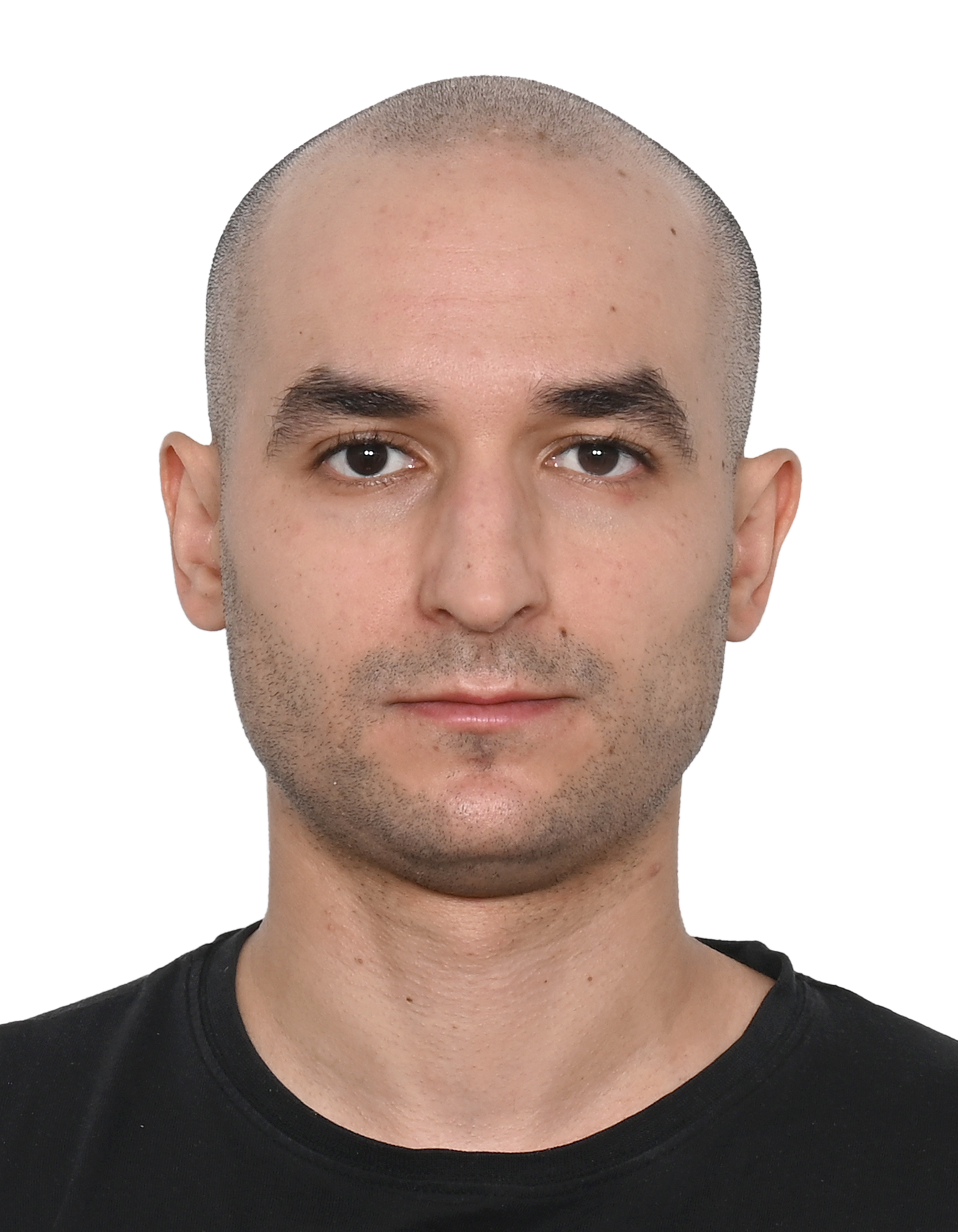Beyond Convexity #1: Introduction to Cross-Convexity
Published:
In this blog post, we introduce a generalized notion of convexity for functions, that we call “cross-convexity”, yielding inequalities that involve additional interaction terms compared to standard convexity.
Definition: A function $F:\mathbb{R}^d \rightarrow \mathbb{R}$ is said cross-convex if there exists $S\ge 1$ log-concave functions $p_1,\dots,p_S$ such that \(\forall x\in \mathbb{R}^d , \ F(x) = -\log\left( \sum_{s=1}^S p_s(x) \right) .\)
If $S=1$, then a cross-convex function is simply convex. In the general case $S\ge 1$, we argue that this family of functions is still a natural one to consider as it includes the negative log-likelihood of the Gaussian mixture model.
Let us first recall that a differentiable function $f:\mathbb{R}^d \rightarrow \mathbb{R}$ is convex if it dominates all its tangent hyperplanes: \(\forall a, \forall x, f(x) \ge f(a) + \nabla f(a)^\top (x-a).\)
$\bullet$ Summation/Affine Closure: A very important characteristic of the family of convex functions is that it is closed under (i) summation and (ii) affine reparametrization. Formally, (i) if $f_1,f_2$ are two convex functions, then $f_1+f_2$ is also convex ; and (ii) if $f$ is convex, then $z \mapsto f(Az+b)$ is also convex. These two closure properties are very important in machine learning where the objective function is typically equal to a sum over the dataset with affine neuronal transformations of the input data. A first challenge when trying to generalize convexity for ML applications is to pick a family of functions satisfying such closedness under summation and affine reparametrization. For instance, while the notion of quasi-convexity is often cited as a natural extension of standard convexity, unfortunately it is not closed under summation since the sum of two quasi-convex functions is not necessarily quasi-convex.
Proposition: Let $F = -\log\left( \sum_{s=1}^S p_s \right)$ and $\tilde F = -\log\left( \sum_{s=1}^{\tilde S} \tilde p_s \right)$ be two cross-convex functions with $S,\tilde S \ge 1$ and $p_s,\tilde p_s : \mathbb{R}^d \rightarrow (0,+\infty)$ log-concave functions. Then, the sum $F+\tilde F$ is also cross-convex. Indeed, \(F+\tilde F = -\log\left( \sum_{s=1}^S \sum_{s'=1}^{\tilde S} p_s \tilde p_{s'} \right) ,\) where the product of two log-concave functions $p_s \tilde p_{s’}$ is also log-concave.
Moreover, the class of cross-convex functions is also closed under affine reparametrization (follows from the closedness of log-concave functions).
$\bullet$ Generalized convexity inequality: Note that the right-hand side in the convexity inequality, namely “$f(a) + \nabla f(a)^\top (x-a)$”, represents the tangent hyperplane of $f$ at the point $a$. In particular, this lower bound is a critical ingredient in the analysis of gradient descent (see e.g. Bach’s LTFP book).
Key Remark: For any element $\mu \in [0,1]^S$ of the probability simplex (i.e., $\lVert \mu \rVert_1=1$), the KL-regularized log-loss \(\ell_\mu(x) = -\log( p_1(x)+\dots+p_S(x) ) + D_{\text{KL}}\left( \mu \Bigg\| \left[ \frac{p_s(x)}{ \sum_{s'} p_{s'}(x) } \right]_{s} \right)\) is convex.
In the following, we explain step-by-step how to obtain a similar lower bound in the cross convex case. For simplicity, we focus on the very specific case $S=2, d=2$ and $p_1(x,y)=p_2(y,x)=p(x)$ for some log-concave function $p: \mathbb{R} \rightarrow (0,+\infty)$, which already unveils phenomena unseen in the convex scenario. We refer the reader to Lemma 1 in “Beyond Log-Concavity: Theory and Algorithm for Sum-Log-Concave Optimization”1 for the more general statement.
Steps
- Given log-concave function $p$
- Compute cross-convex function $F(x,y)=-\log(p(x)+p(y))$
- Tangent lower bound $\mathcal{T}_{a,b}(x, y) \le F(x,y)$ at point $(a,b)$: \(\mathcal{T}_{a,b}(x, y) = F(a,b) + \nabla F(a,b)^\top \begin{pmatrix} x-a \\ y-b \end{pmatrix} - D_{\text{KL}}\left( \begin{pmatrix} \frac{p(a)}{p(a)+p(b)} \\ \frac{p(b)}{p(a)+p(b)} \end{pmatrix} \, \Bigg \| \, \begin{pmatrix} \frac{p(x)}{p(x)+p(y)} \\ \frac{p(y)}{p(x)+p(y)} \end{pmatrix} \right)\)
- Note: Actually, the negative sign in front of the KL is bad news for the analysis of gradient descent…check out my paper to see how to solve that issue, by considering a reweighted version of the gradient
$\bullet$ \(\mathfrak{B}\)estiary: Collection of illustrations of cross-convex functions (in red) with their tangent surface (in green): https://github.com/mastane/TheXCB. The green tangent surface represents the lower bound $\mathcal{T}_{0,0}$ in the generalized convexity inequality.
\(\mathcal{G}\)aussian mixture
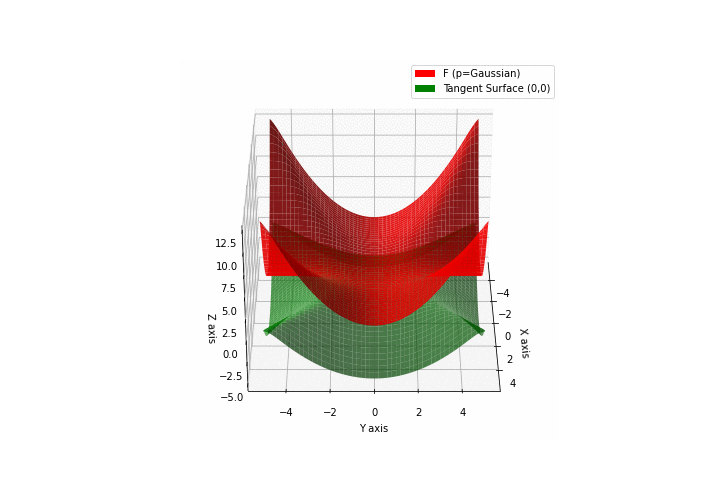
\(\mathcal{L}\)ogistic mixture
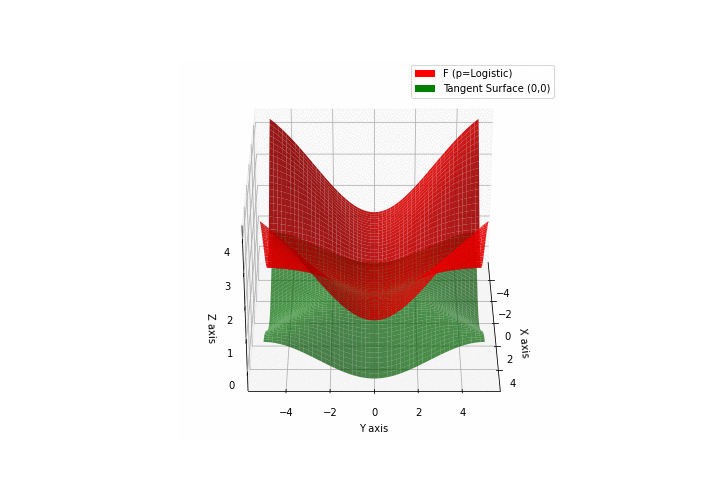
\(\mathcal{H}\)yperbolic \(\mathcal{S}\)ecant mixture
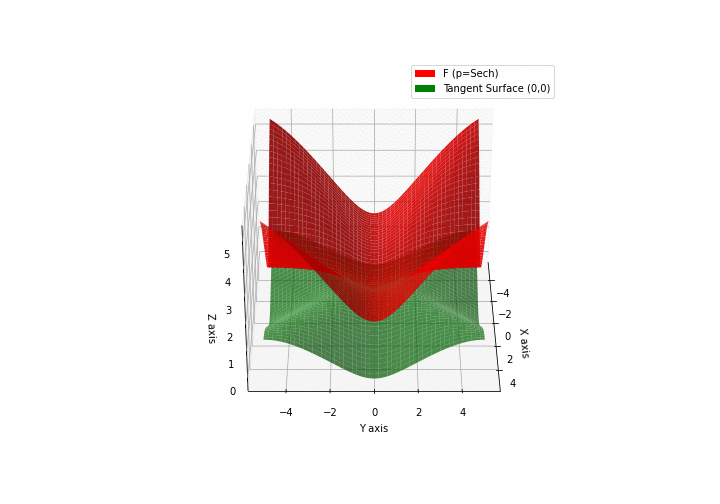
\(\mathcal{G}\)umbel mixture
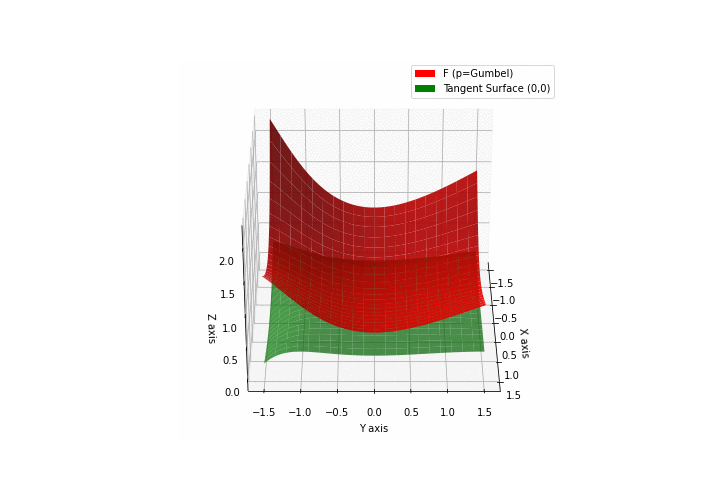
Note: in Proposition 5.7 the cross gradient formula further simplifies to \(\left[ \sigma_l(Z_k) - \frac{\sigma_l(Z'_k) \Xi_{m-1,y-l}(Z'_{-k})}{\Xi_{m,y}(Z')} \right]_{0\le l\le c-1}.\) ↩
